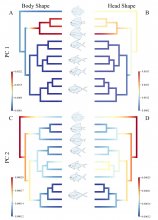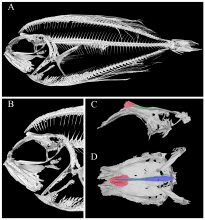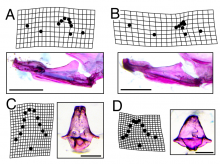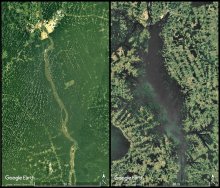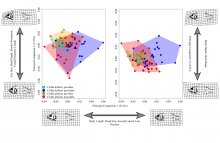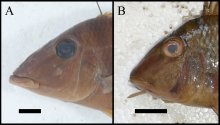Michelle Gilbert

PhD Candidate
M.S. in Biology, Western Kentucky University, 2016
B.S. in Biology, Murray State University, 2014
Research Interests
My research is broadly centered around understanding the origin of shape, evolution of form, and the connection between form and function. To answer my questions, I focus on fishes, which have more species diversity that all other vertebrates combined. What makes fishes such a good system for understanding shape, you ask? Well, fishes come in all shapes and sizes! From round fish to flattened fish, square fish to diamond fish, to fish built for speed to fish that leave one wonder why their shape exists (we're all thinking, Mola mola), fish provide a perplexing and beautiful system to study the intricates of shape evolution.
To answer my questions, my approach relies on geometric morphometric methods to investigate patterns of morphological change and I frequently integrate shape data with genetic, environmental, or phylogenetic data to better understand broad evolutionary mechanisms.
Historical contingency, Pareto Optimality, and evolutionary constraints
One topic in evolutionary biology that I have consistently been drawn to, and frequently find myself enamored with, is how history influences adaptive peaks and evolutionary trajectories. Whether this is in the context of functional constraints imposed on a mechanical system, or developmental constraints imposed on patterning and phenotypic development, or evolutionary constraints that can marry the two, the field is rich with enticing questions and inspiring concepts.
Most recently, I have utilized an enigmatic group of ocean ocean fishes that are greatly understudied to explore how extreme phenotypes can introduce both functional and evolutionary constraints throughout a lineage. For more details, please see Gilbert et al 2021. DOI: https://doi.org/10.1093/iob/obab003
Genotype to phenotype and the curiosities that surround plasticity
Phenotypic plasticity is a fascinating concept in biology that can be simplified to the capacity for a different populations of an organism to adapt to their environment, allowing for a single genotype to produce a variety of phenotypes. Cool! Right? But how can that work? What allows for the phenotypic response to the environment to be distinct from the genotype? Or is it?
Using a number of approaches, some of my work aims to clarify some of th e genetic underpinnings of phenotypic plasticity how it is facilitated across different organisms. While some of my work has circled around how the environment can shape morphology, some other recent work has involved how both the environmental and the genotype work in tandem or produce the o bserved phenotype. For more information, stay tuned for Gilbert and Tetrault et al in revision (with minor revisions).
Contemporary evolution in response to anthropogenic change
The world is changing at ever increasing pace, largely due to human population growth and the demand for resources to sustain such growth. While anthropogenic (human-induced, that is) change typically brings misfortune to ecological systems, some offer opportunities to study how rapid environmental change can spur evolution.
With a similar interest to phenotypic plasticity, I've been exploring how rapidly changing environments can induce plastic responses in resident fish populations, spurring differing morphologies to arise in short time periods and within generations. I have explored these concepts in a few different systems, but primarily in the cichlid populations of the Tocantins river system, which has been subjected to extreme damming and waterway manipulation over the past century. For more information, please see Gilbert et al 2020. DOI: https://doi.org/10.1111/eva.13080
Publications
Olsen, M, MC Gilbert. In prep. Habitat fragmentation as a means of spurring phenotypic evolution in an endangered species.
Gilbert, MC, E Tetrault, M Packard, D Navon, RC Albertson. In Review. Ciliary rootlet coiled-coil 2 (crocc2) underlies evolutionary divergence and plasticity of cichlid jaw shape.
Gilbert, MC, AJ Conith, C Lerose*, JK Moyer, SH Huskey, RC Albertson. 2021. Extreme morphology, functional trade-offs, and evolutionary dynamics in a clade of open-ocean fishes. Integrative Organismal Biology - https://doi.org/10.1093/iob/obab003
Gilbert, MC, A Akama, C Cox Fernandes, RC Albertson. 2020. Rapid morphological change in multiple cichlid ecotypes following the damming of a major clearwater river in Brazil. Evolutionary Applications - https://doi.org/10.1111/eva.13080
